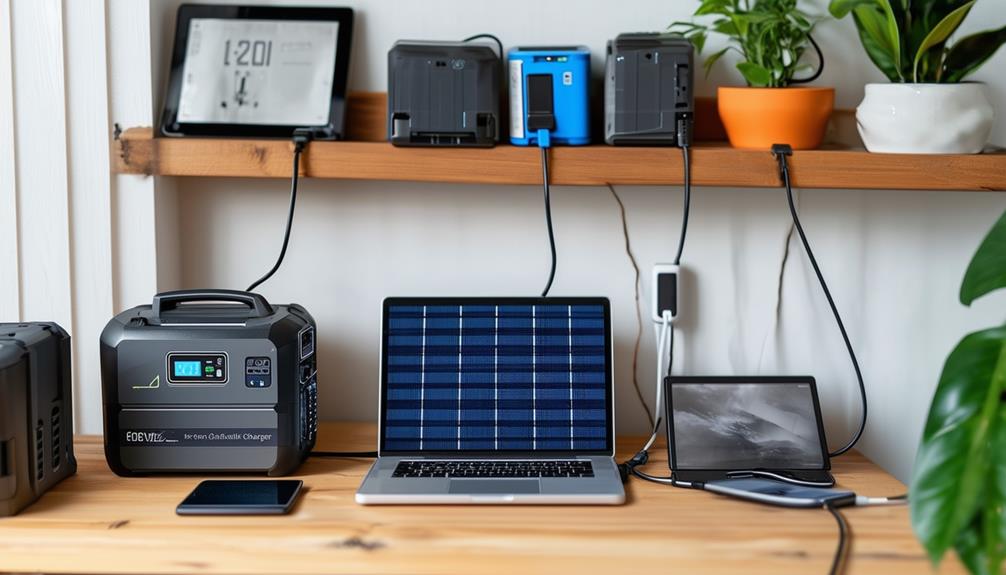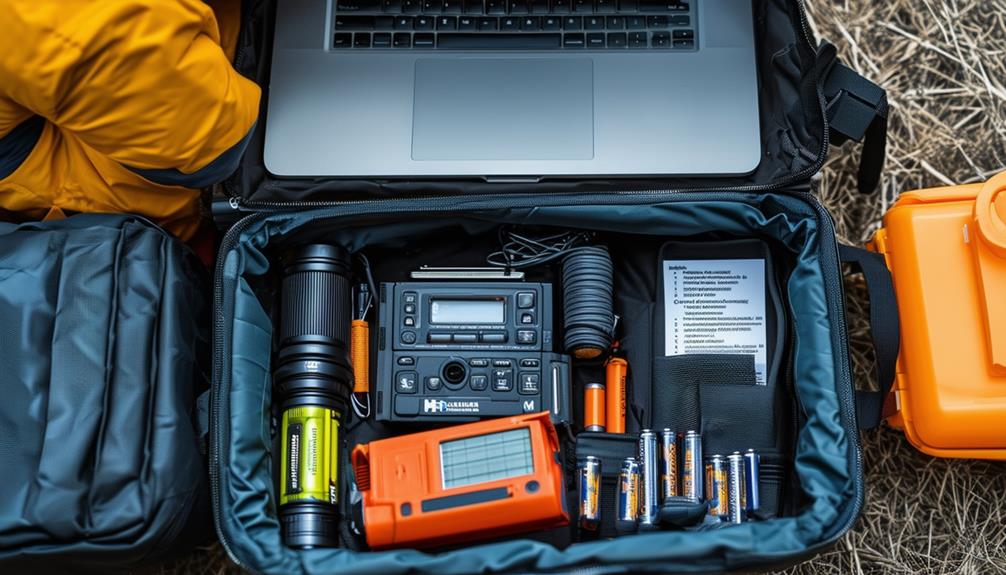In a world increasingly reliant on technology, thoroughly examining for potential electromagnetic pulse (EMP) events is paramount to safeguarding your electronics. The looming threat of EMPs can wreak havoc on our interconnected devices, disrupting essential services and communication systems. By exploring strategic methods such as Faraday Cages, backup power sources, and EMP shielding techniques, individuals can fortify their electronics against these invisible yet powerful disruptions. As we investigate the intricate web of prepping for EMP scenarios, understanding the nuances of safeguarding our electronics becomes not just a precaution but a necessity for ensuring our resilience in the face of such unpredictable disruptions.
Understanding EMP Threats
Understanding EMP threats is essential for developing effective protection strategies for electronic devices. An Electromagnetic Pulse (EMP) is a burst of electromagnetic radiation that can disrupt, damage, or destroy electronic equipment and systems. EMPs can be caused by natural sources like lightning or solar flares, but they can also be generated by man-made devices such as nuclear weapons or radiofrequency weapons.
The high-energy EMP from a nuclear detonation can induce damaging currents and voltages in electronic circuits, leading to widespread failures in devices like computers, communication systems, and power grids.
To effectively safeguard electronic devices against EMP threats, it is vital to analyze the potential sources and strengths of EMPs that could affect the devices. Understanding the vulnerabilities of electronic systems and components to different types of electromagnetic disturbances is key to developing protective measures like shielding and grounding.
Importance of Faraday Cages
To enhance the protection of electronic devices against EMP threats, the importance of utilizing Faraday Cages cannot be understated. Faraday Cages are essential for shielding electronics from the damaging effects of electromagnetic pulses. These cages work by creating a conductive enclosure that prevents electromagnetic fields from penetrating and reaching the sensitive components inside.
By effectively blocking out external electromagnetic radiation, Faraday Cages safeguard devices such as radios, laptops, and other critical electronics from being fried or disrupted during an EMP event.
When constructing a Faraday Cage, it is vital to make sure that the enclosure is made of conductive materials such as copper or aluminum. The cage must be properly sealed to prevent any gaps that could allow electromagnetic waves to penetrate. Additionally, grounding the Faraday Cage is necessary to dissipate any excess electromagnetic energy that the cage may absorb.
Backup Power Sources

An essential component of safeguarding your electronics against EMP threats involves establishing reliable backup power sources for uninterrupted functionality during and after an electromagnetic pulse event.
When selecting backup power sources, consider portable generators, solar panels with battery storage, or power banks. Portable generators are versatile and can provide substantial power for extended periods, but they require fuel and regular maintenance.
Solar panels with battery storage offer a vital solution, harnessing energy from the sun and storing it for later use.
Power banks are compact and convenient for charging smaller devices like smartphones and tablets, providing a quick power boost when needed.
It is crucial to calculate the power requirements of your essential electronics to determine the capacity needed for your backup power source. Prioritize devices that are critical for communication, medical needs, and emergency situations.
Regularly test and maintain your backup power sources to make certain they are operational when required.
EMP Shielding Techniques
Effective EMP shielding techniques are essential for safeguarding electronics against electromagnetic pulse threats. One common method is using Faraday cages, which are enclosures made of conductive materials that divert the electromagnetic energy away from the electronics inside. These cages can be as simple as a metal box or as complex as a specially designed room with conductive walls, floors, and ceilings. Ensuring that all seams and openings are properly sealed is vital for maximum protection.
Another effective technique is the use of shielding bags or wraps made of materials like aluminum or copper. These bags provide a portable solution for safeguarding individual electronic devices from EMP damage. It is important to choose high-quality bags with proper sealing mechanisms to ensure effectiveness.
Additionally, installing surge protectors and filters in electronic devices can help mitigate the impact of EMPs by diverting excess energy away from the sensitive components. Proper grounding of electronic equipment is also crucial to prevent damage from EMP-induced power surges.
Securing Electronic Devices

Securing electronic devices against electromagnetic pulse threats requires a comprehensive approach that encompasses both physical and digital protection measures. Physically safeguarding devices involves storing them in Faraday cages or shielded enclosures to block EMP effects. Additionally, grounding cables and surge protectors can help mitigate the impact of electromagnetic interference.
Digital protection measures include backing up data on offline storage devices regularly to guarantee information remains accessible in case of an EMP event. Employing encryption and strong passwords adds an additional layer of security to prevent unauthorized access to sensitive data.
Furthermore, installing EMP shielding devices such as transient voltage suppressors and metal oxide varistors on electronic circuits can help divert excess energy from damaging components. Regularly updating software and firmware on devices is vital to patch any vulnerabilities that could be exploited during an EMP incident.
Emergency Communication Plans
Developing a strong emergency communication plan is vital for ensuring effective coordination and information dissemination during unforeseen events. When creating your plan, consider establishing multiple communication channels to account for potential disruptions. Include both primary and secondary methods such as cell phones, radios, satellite phones, and messaging apps to guarantee redundancy.
Assign specific roles and responsibilities to individuals within your group or community to streamline communication flow and avoid confusion during emergencies. It is essential to establish predetermined meeting points or rally locations to regroup if communication devices fail.
Practice your communication plan regularly to confirm everyone is familiar with the procedures and can execute them swiftly when needed. Additionally, consider implementing a system for checking in with each other periodically to confirm safety and well-being.
Essential Supplies Checklist

When preparing for potential disruptions like an EMP event, having an organized and well-stocked essential supplies checklist is essential to ensuring your group's readiness and survival. Start by ensuring an ample supply of non-perishable food items such as canned goods, freeze-dried meals, and energy bars to sustain your group for an extended period.
Water is critical, so store at least one gallon per person per day for drinking and sanitation needs. Basic medical supplies including first aid kits, prescription medications, and hygiene products are crucial for maintaining health during crises.
Additionally, having a reliable source of light such as flashlights, lanterns, and extra batteries is important for visibility at night. Communication devices like two-way radios and emergency radios can help keep your group connected and informed.
Testing Electronics Vulnerability
To assess the susceptibility of your electronics to an EMP event, conducting thorough vulnerability testing is imperative. This process involves subjecting your devices to simulated electromagnetic pulses to evaluate their resilience.
Here are some key steps to contemplate when testing your electronics for vulnerability:
- Conducting EMP Simulation: Utilize specialized equipment to generate electromagnetic pulses similar to those produced by an EMP event.
- Testing Multiple Devices: Evaluate a variety of electronics including laptops, smartphones, radios, and other critical devices to identify weak points.
- Measuring Impact: Assess the impact of the simulated EMP on each device, noting any malfunctions, data loss, or physical damage.
- Implementing Shielding Solutions: Based on the test results, contemplate adding shielding materials or Faraday cages to protect vulnerable electronics from EMP effects.
Frequently Asked Questions
Can EMPS Affect All Electronic Devices Equally?
Electromagnetic pulses (EMPs) can impact electronic devices differently based on factors like proximity, shielding, and device type. High-energy EMPs can potentially damage all electronic devices, but the extent of the impact varies depending on these variables.
How Long Do Faraday Cages Protect Electronics?
Faraday cages shield electronics from electromagnetic pulses (EMPs) by redirecting currents around the enclosed items. The duration of protection depends on cage construction, EMP intensity, and frequency. Regular testing and maintenance can guarantee continued effectiveness in safeguarding electronics.
Are Solar Panels Safe From EMP Damage?
Solar panels are generally resilient to EMP damage due to their simple design and lack of delicate electronics. However, damage can occur to associated components like inverters. Shielding these essential parts within a Faraday cage can help mitigate potential risks.
Can EMP Shielding Be Diy?
DIY EMP shielding can be challenging due to the complexity of electromagnetic pulse (EMP) protection requirements. It typically involves specialized materials and precise installation techniques. Professional consultation or pre-made EMP shielding solutions are recommended for best protection.
How Do I Safely Dispose of Damaged Electronics Post-Emp?
When disposing of damaged electronics post-EMP, guarantee safety by following proper e-waste disposal guidelines. Seek certified electronic recycling facilities to prevent environmental contamination and protect personal data. Consider data wiping or destruction services for added security.
Conclusion
To sum up, safeguarding electronics from electromagnetic pulses (EMPs) is crucial for maintaining operational readiness and resilience. Understanding EMP threats, utilizing Faraday Cages, securing backup power sources, and implementing EMP shielding techniques are essential steps in protecting electronic devices from potential damage.
By identifying vulnerabilities, measuring the impact of EMP exposure, and implementing effective shielding solutions, individuals can mitigate the risks associated with electromagnetic disturbances and guarantee the functionality of critical devices.

